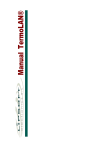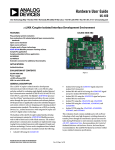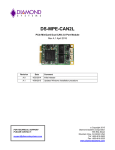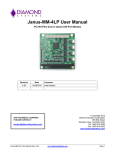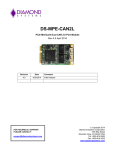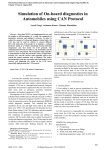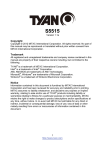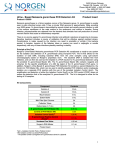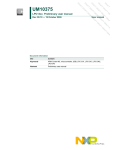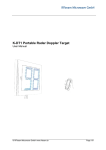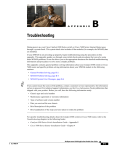Download User Guide
Transcript
User Guide TCB1000 Series CANbus, Socket Modem & Serial Communication Rev 09/11 Tri-M Technologies Inc. 101 – 1530 Kingsway Avenue Port Coquitlam, BC V3C 6N6 Toll Free: 800.665.5600 Direct: 604.945.9565 Fax: 604.945.9566 Web: www.tri-m.com Email: [email protected] Preface Important Notes This manual is intended for integrators of embedded system applications. It contains detailed information on hardware and software requirements to interconnect to other embedded devices. Carefully read this manual before you begin installation. About Tri-M Technologies Inc. Tri-M Technologies Inc. specializes in embedded computing for rugged environments. Tri-M’s innovative solutions are the premiere choice for off-highway vehicles, industrial controls, robotics, military equipment, aerospace technologies, undersea and advanced security products. We offer a wide range of DC-to-DC converters, CPU boards, hardened enclosures, I/O modules, wireless communication devices, and customized systems. With over 28 years of industry experience, Tri-M is your embedded systems specialist. Technical Support Tri-M is pleased to provide technical support and services by phone, live chat, and email: • • • For User Guides, FAQ’s and RMA’s, please visit us at www.tri-m.com/support For Email support, please contact our staff at [email protected] To speak with a technical support representative, call us at 1.800.665.5600 or +1.604.945.9565 Tri-M Technologies Inc. (Limited Warranty) Unless otherwise agreed to in writing, Tri-M Technologies Inc. (Tri-M) warrants to the original purchaser that its products will be free from defects in material and workmanship for a period of (1) one year from the date of shipment. Tri-M’s obligation under this warranty is limited to replacement or repair at its option and its designated site. Any such products must be returned within the warranty period to Tri-M in Tri-M approved packaging with a Tri-M-assigned RMA (Return Material Authorization) number referenced on the shipping documents. All warranties are void if there is evidence of misuse, tampering, or attempted repair of parts. Any returns must be accompanied by a return material authorization (RMA) number issued by Tri-M. Purchaser shall prepay transportation to Tri-M’s designated site. If returned products are repaired or replaced under the terms of this warranty, Tri-M shall pay return transportation charges. In no case will Tri-M be held liable for consequential damages arising out of its obligations under this warranty or the failure or incorrect use of any of its products. This warranty is in lieu of all warranties, either express or implied, including, without limitation, any implied warranty of merchantability or fitness for any particular purpose, and of any other obligation on the part of Tri-M. Disclaimer No part of this document may be reproduced, transmitted, transcribed, stored in a retrieval system, or translated into any language or computer language, in any form or by any means, electronic, mechanical, magnetic, optical, chemical, manual, or otherwise, without the express written permission of Tri-M Technologies Inc. Tri-M Technologies Inc. (Tri-M) makes no representations or warranties with respect to the contents of this manual, and specifically disclaims any implied warranties of merchantability or fitness for any particular purpose. Tri-M shall under no circumstances be liable for incidental or consequential damages or related expenses resulting from the use of this product, even if it has been notified of the possibility of such damages. Tri-M reserves the right to revise this publication from time to time without obligation to notify any person of such revisions. COPYRIGHT © 2011 TRI-M TECHNOLOGIES INC. TCB1000 Series Rev 09/11 Page 2 Preface Table of Contents Preface Important Notes................................................................................................... 2 About Tri-M Technologies Inc. ........................................................................ 2 Technical Support............................................................................................ 2 Tri-M Technologies Inc. (Limited Warranty)..................................................... 2 Disclaimer....................................................................................................... 2 Introduction Overview.............................................................................................................. 5 Key Features....................................................................................................... 5 Optional Items...................................................................................................... 5 Specifications....................................................................................................... 6 Electrical.......................................................................................................... 6 Mechanical...................................................................................................... 6 Environment.................................................................................................... 6 Communication............................................................................................... 6 Certifications................................................................................................... 6 Block Diagram..................................................................................................... 7 Dimensions.......................................................................................................... 8 Connector Layout................................................................................................ 9 Connectors Connector Specifications..................................................................................... 10 PC/104 8bit Bus (CN1).................................................................................... 10 PC/104 16bit Bus (CN2).................................................................................. 11 RS232 Ports (CN3, CN4, CN5, CN6).............................................................. 12 RS485 Port (CN7)........................................................................................... 13 TCB1000 Series Rev 09/11 Page 3 Preface JTAG Port (CN8 Top)...................................................................................... 14 USB Port (CN8 Bottom).................................................................................. 14 LED Port (CN9)............................................................................................... 15 Universal MultiTech Sockets (CN10, CN11) ................................................... 16 CAN BUS (CN12, CN13)................................................................................ 17 Configuration Configuration Overview....................................................................................... 18 Command-line Configuration Setup................................................................ 18 Mass-Storage Configuration Setup................................................................. 19 Command-line Configuration.......................................................................... 20 UART 1....................................................................................................... 20 UART 2....................................................................................................... 21 Serial Port Enable/Disable.......................................................................... 22 DSR............................................................................................................ 22 RS485......................................................................................................... 23 SOCKET RESET........................................................................................ 23 CAN MODE................................................................................................ 24 CAN 1......................................................................................................... 24 CAN 2......................................................................................................... 25 HEART BEAT............................................................................................. 25 TEMP.......................................................................................................... 25 ALARM MESSAGE.................................................................................... 26 CONFIG...................................................................................................... 26 Appendix A ........................................................................................................... 27 TCB1000 Series Rev 09/11 Page 4 Introduction Overview Tri-M’s TCB1000 Series features dual SJA1000 CANbus controllers, isolated serial ports, and two MultiTech Universal compatible sockets on a single PC/104 board design. This high density communication board offers an all-in-one communication solution, optimizing Size, Weight, and Performance (SWaP) requirements. This innovative product is an industry first, and takes full advantage of the latest technologies in jumperless configuration, high voltage isolation and advanced communication functionality. The TCB1000 Series includes 2 galvanic isolated CANbus controllers with 2500V isolation protection and advanced networking and configuration capabilities. The 4x RS232 Ports and 1x RS485 Port features 2500V isolation protection and individual +5VDC isolated power supplies, thus providing less noise and increased system protection. With USB connectivity and jumperless setup, extended operating temperature, and versatile options, Tri-M’s TCB1000 Series is your perfect choice for CANbus, serial, and wired or wireless communication. To learn more and take advantage of this rugged and innovative design, please contact us at 1-800-665-5600 or visit us at http://www.tri-m.com/products/trim/tcb1000.html. Key Features • • • • • All-in-one PC/104 communication solution for CANbus, serial port, and wired and wireless communication (including optional GPS functionality) High voltage (2500V) port isolation to reduce noise and increase system protection Advanced CANbus functionality, such as socket network device operation, adding flexibility to your embedded system in order to reduce development time, cost, and installation setup Jumperless configuration with secure lock, ensuring uniformity and maximizing system security Extended operating temperature -40°C to +85°C (-40°F to 185°F), suited for outstanding performance and reliability in harsh environments Optional Items Tri-M offers the following options for the TCB1000 Series. For more information please visit us at http://www.tri-m.com/products/trim/conformal.html or call 1.800.665.5600. • Conformal Coating (Options - CS, CH, CH1, AND CU) Ruggedized protection against the elements such as temperature (CS), fungal resistance (CH), and humidity & chemical (CU) TCB1000 Series Rev 09/11 Page 5 Introduction Specifications Electrical Supply Voltage +5 VDC Aux Port Output Current 200mA per Port Aux Port Output Isolation 2500V maximum Mechanical Dimensions PC/104 Compliant, 90mm x 96mm x 15mm (3.55” x 3.775” x 0.6”) Weight 52g (1.9oz) Environment Operating Temperature -40°C to +85°C (-40°F to 185°F) Communication CANbus 2 x SJA1000 Controllers, 1Mbp/s maximum RS232 4 x Isolated Ports, 921Kbp/s maximum RS485 1 x Isolated Port, 921Kbp/s maximum Universal MultiTech Sockets 2 x MultiTech Compatible Sockets, 921Kbp/s maximum LED Indicators 5 x Isolated LED’s, built-in limiting resistors USB/JTAG 1 x USB/JTAG port for easy installation setup Certifications Manufactured in RoHS compliant ISO 9001:2008, ISO 14001:2004 & ANSI/ESD S20.20 Environments TCB1000 Series Rev 09/11 Page 6 Introduction Block Diagram PC/104 Bus For a detailed block diagram, please see Appendix A. Dual Isolated CAN SJA1000 MCU & Logic Isolated RS232 Isolated RS485 Universal MultiTech Slots CAN PORT 1 CAN PORT 2 4x RS232 1x RS485 2x Universal Sockets USB JTAG TEMP TCB1000 Series Rev 09/11 Page 7 Introduction Dimensions Note Dimensions are in mil (.001 inch) and millimeters (mm) TCB1000 Series Rev 09/11 Page 8 Introduction Connector Diagram CN12 CN7 CN10 CN13 CN3 CN4 CN9 CN5 CN11 CN8 CN6 CN1 CN2 Label TCB1000 Series Connector Description CN1 PC104 8-bit Bus 2x32 press-fit header CN2 PC104 16-bit Bus 2x20 press-fit header CN3 RS232 Port 1 2x5 right-angle shroud 0.1” pins CN4 RS232 Port 2 2x5 right-angle shroud 0.1” pins CN5 RS232 Port 3 2x5 right-angle shroud 0.1” pins CN6 RS232 Port 4 2x5 right-angle shroud 0.1” pins CN7 RS485 Port 2x5 right-angle shroud 0.1” pins CN8 JTAG (TOP) / USB (BOTTOM) 2x5 right-angle 0.1” pins (2) (Top/Bottom) CN9 5 Isolated LED’s 2x5 right-angle shroud 0.1” pins CN10 SOCKET PORT 1 Supports Tri-M and Universal MultiTech Modules CN11 SOCKET PORT 2 Supports Tri-M and Universal MultiTech Modules CN12 CAN BUS 1 2x5 right-angle shroud 0.1” pins CN13 CAN BUS 2 2x5 right-angle shroud 0.1” pins Rev 09/11 Page 9 Connectors Connector Specifications The following sections describe the mechanical and pinout specifications. For configuration and setup information, please see the Configuration section. PC/104 8-bit Bus (CN1) CN1 is a PC/104 ISA 8-bit bus with pass-through connectors. Tri-M also accommodates non-passthrough and non-PC/104 compliant customizations. CN1 B1 B32 A32 TOP VIEW PC/104 8-bit Connector (CN1) Pin Signal Pin Signal Pin Signal Pin Signal A1 /IOCHCK B1 GND A17 SA14 B17 /DACK1 A2 SD7 B2 RESETDRV A18 SA13 B18 DRQ1 A3 SD6 B3 +5V A19 SA12 B19 /REFRESH A4 SD5 B4 IRQ9 A20 SA11 B20 SYSCLK A5 SD4 A6 SD3 B5 -5V A21 SA10 B21 IRQ7 B6 DRQ2 A22 SA9 B22 N/A A7 SD2 B7 -12V A23 SA8 B23 IRQ5 A8 SD1 B8 /0WS A24 SA7 B24 IRQ4 A9 SD0 B9 +12V A25 SA6 B25 IRQ3 A10 IOCHRDY B10 GND A26 SA5 B26 /DACK2 A11 AEN B11 /SMEMW A27 SA4 B27 TC A12 SA19 B12 /SMEMR A28 SA3 B28 BALE A13 SA18 B13 /IOW A29 SA2 B29 +5V A14 SA17 B14 /IOR A30 SA1 B30 OSC A15 SA16 B15 DACK3 A31 SA0 B31 GND A16 SA15 B16 DRQ3 A32 GND B32 GND TCB1000 Series Rev 09/11 Page 10 Connectors PC/104 16-bit Bus (CN2) CN2 is a 16-bit bus with pass-through connectors. Tri-M also accommodates non-pass-through and non-PC/104 compliant customizations. CN2 C0 DO C19 D19 TOP SIDE Pin TCB1000 Series PC/104 16-bit Connector (CN2) Signal Pin Signal C0 GND D0 GND C1 /SBHE D1 /MEMCS16 C2 LA23 D2 /IOCS16 C3 LA22 D3 IRQ10 C4 LA21 D4 IRQ11 C5 LA20 D5 IRQ12 C6 LA19 D6 IRQ15 C7 LA18 D7 IRQ14 C8 LA17 D8 /DACK0 C9 /MEMR D9 DRQ0 C10 /MEMW D10 /DACK5 C11 SD8 D11 DRQ5 C12 SD9 D12 /DACK6 C13 SD10 D13 DRQ6 C14 SD11 D14 /DACK7 C15 SD12 D15 DRQ7 C16 SD13 D16 +5V C17 SD14 D17 /MASTER C18 SD15 D18 GND C19 GND D19 GND Rev 09/11 Page 11 Connectors RS232 Ports (CN3, CN4, CN5, CN6) CN3 to CN6 are the RS232 Ports 1 to 4. These ports are galvanic isolated up to 2500V and have a maximum baud rate of 921Kbp/s. These isolated ports reduce noise and increases system protection. The pin spacing is 2.54mm (0.1”). RS232 PORT 3 RS232 PORT 4 1 1 1 1 RS232 PORT 4 RS232 PORT 3 TOP VIEW RS232 Port 4 CN6 1 9 RS232 Port 3 CN5 1 RS232 Port 2 CN4 1 9 RS232 Port 1 CN3 1 100mil (2.54mm) 10 2 PCB SIDE VIEW RS232 Ports 1 to 4 (CN3, CN4, CN5, CN6) Top Bottom Pin Signal Pin Signal 1 NC 2 NC 3 RX 4 RTS 5 TX 6 CTS 7 NC 8 NC 9 GNDISO 10 VCC5VISO Note GNDISO and VCC5VISO are independently isolated TCB1000 Series Rev 09/11 Page 12 Connectors RS485 Port (CN7) CN7 is the RS485 Port. This port is galvanic isolated up to 2500V and has a maximum baud rate of 921Kbp/s. The port isolation reduces noise and increases system protection. The port also features a terminating 120Ω resistor setting which can be set to open or closed. Please see the Configuration section for more details. The pin spacing is 2.54mm(0.1”). 1 RS485 PORT 5 RS485 Port CN7 1 9 100mil (2.54mm) 10 2 PCB SIDE VIEW RS485 Port (CN7) Top Bottom Pin Signal Pin Signal 1 NC 2 NC 3 RX+ 4 TX+ 5 TX- 6 RX- 7 NC 8 Z120Ω Enable 9 GNDISO 10 VCC5VISO Note The software configuration command ‘RSZ’ will take precedence when set. Please see the Configuration section for more details. TCB1000 Series Rev 09/11 Page 13 Connectors JTAG Port (CN8 Top) CN8 is the JTAG and USB Port comprised of two 1x5 headers. The top side of CN8 is the JTAG Port. It provides programming and debugging capabilities for the CPLD. The pin spacing is 2.54mm(0.1”). Note This port is for factory use only. 1 JTAG/ USB PORT Top VIEW JTAG/USB Port CN8 5 1 JTAG USB JTAG Port (CN8) Pin Signal 100mil (2.54mm) 2 PCB 1 VCC3V3 3 TMS 5 TCK 7 TDI 9 TDO SIDE VIEW USB Port (CN8 Bottom) The bottom side of CN8 is the USB Port, used to setup and configure the TCB1000. For configuration details, please see the Configuration section. The pin spacing is 2.54mm(0.1”). JTAG USB J TA G / U S B Port CN8 1 USB Port (CN8) Pin Signal 100mil (2.54mm) 10 2 PCB SIDE VIEW TCB1000 Series Rev 09/11 2 VCCUSB 4 D- 6 D+ 8 GND 10 ISP Page 14 Connectors LED Port (CN9) CN9 are the 5 LED Ports. These ports monitor the 4x RS232 and 1x RS485 signals. They are independently isolated up to 2500V, and do not require any limiting resistors, allowing you to directly connect an LED to the port. To configure the LED’s, please see the Configuration section. The pin spacing is 2.54mm(0.1”). 1 LED PORT Top VIEW LED Port CN9 Note + is the Anode, and - is the Cathode 9 10 ----- 1 100mil (2.54mm) + + + + +2 PCB SIDE VIEW LED Port (CN9) Top Bottom Pin Signal Pin Signal LED1 1 LED- 2 LED+ LED2 3 LED- 4 LED+ LED3 5 LED- 6 LED+ LED4 7 LED- 8 LED+ LED5 9 LED- 10 LED+ Note LED- and LED+ are independently isolated TCB1000 Series Rev 09/11 Page 15 Connectors Universal MultiTech Sockets (CN10, CN11) There are two Universal MultiTech compatible sockets capable of serial and wireless or wired communication. Tri-M developed its own GPS module and provides a variety of socket modules including Ethernet, CDMA, GSM, GPRS, Wi-Fi and Bluetooth. For specific product information, please visit http://www.tri-m.com/products/multitech/. CN10 SOCKET 1 CN11 SOCKET 2 Top VIEW (I/O)Tip (I/O) Ring Safety Void (O) TX+ (O) TX(I) RX+ (I) RXSafety Void (O) TCLK (O) RCLK (I) MIC+ (I) MIC(I) -RESET (I) USB_VBUS (I) GND (I/O) USB_DP (I/O) USB_DN (O) LED DCD (O) LED RX (O) LED DTR (O) LED TX TCB1000 Series 1 2 3 4 5 6 7 8 9 10 11 12 13 14 15 16 17 18 19 20 21 22 23 24 25 26 27 28 29 30 31 32 MultiTech Universal Socket Rev 09/11 64 63 62 61 60 59 58 57 56 55 54 53 52 51 50 49 48 47 46 45 44 43 42 41 40 39 38 37 36 35 34 33 SPKR (O) GND (I) MICV (I) VCC (I) -LED SPD (O) -LED COL (O) -LED LINK (O) -LEC ACT (O) -LED FDX (O) GPIO (I/O) GPIO (I/O) GPIO (I/O) GPIO (I/O) SPK+ (O) SPK- (O) GND (I) -DTR (I) -DCD (O) -CTS (O) -DSR (O) -RI (O) -TXD (I) -RXD (O) -RTS (I) Page 16 Connectors CAN BUS (CN12, CN13) There are two NXP SJA1000 Controller Area Network (CAN) controllers providing up to 2500V channel isolation and high input impedance for maximum protection in harsh environments. They are configurable for BasicCAN and PeliCAN. The pin spacing is 2.54mm(0.1”). The CAN transceiver has thermal shutdown protection, maximum speeds up to 1 Mb/s, and slope control for EMI protection. It has a jumperless impedance setting, and unpowered nodes do not disturb the bus resulting in secure and reliable network signaling. Another great feature is the flexibility to access the CAN as a socket network device. To configure the CANbus, please see the Configuration section. 1 1 CAN PORT 1 CAN PORT 2 TOP VIEW CAN 2 CN13 9 1 9 CAN 1 CN12 1 100mil (2.54mm) 10 2 PCB SIDE VIEW CAN BUS (CN12, CN13) Top Bottom Pin Signal Pin Signal 1 N.C. 2 GND ISO 3 CAN- 4 CAN+ 5 GND ISO 6 LOAD ON 7 LOAD T 8 +5VDC ISO 9 N.C. 10 N.C. Note To enable Z, connect LOAD T and LOAD ON TCB1000 Series Rev 09/11 Page 17 Configuration Configuration Overview The configuration setup uses a state of the art jumperless embedded design. This gives you quick and easy remote and direct access to the board without having to dissemble and reassemble your stack. The jumperless design is also a key element for ruggedization and protection for shock and vibration. The TCB also features a configuration lock to secure your settings from undesirable changes. There are two methods to configure the TCB1000: Command-line and Mass-Storage. Command-line Configuration Setup You can access the TCB’s Serial Port 8 remotely or directly by connecting a USB cable. Connecting remotely involves identifying and accessing the COM port using a ‘terminal’ command-line application. Connecting directly entails configuring the USB cable in CDC (communication device class) mode, thus enabling a USB Virtual COM Port. You can then use a ‘terminal’ application to configure the device. TCB1000 directly accessed using a USB Cable as a Virtual COM Port TCB1000 (Powered) USB Cable USB Virtual COM Port Terminal Command-Line Application TCB1000 remotely accessed via a Stack TCB1000 (Powered in a Stack) Monitor connected to the Stack Terminal Command-Line Application Note If you lock your configuration settings, they can only be unlocked using the USB Virtual COM in CDC mode TCB1000 Series Rev 09/11 Page 18 Configuration Mass-Storage Configuration Setup Once you have determined your configuration settings using the Command-line method, you can lock your settings and export them into a ‘config.txt’ file. Using the USB cable in MSC (mass-storage device class) mode, you can ‘drag and drop’ your configuration profile to and from the device. Note that the TCB1000 does not need power in MSC mode, adding greater flexibility and ease in configuring your device. TCB1000 configured as a Mass-Storage device TCB1000 (Powered or Unpowered) USB Cable Configured as USB Mass Storage Drag and Drop Note You do not need to power the board when connecting the USB cable for Mass-Storage mode, and it may take up to 25 seconds to identify and mount the device (NXP LPC1342). ! TCB1000 Series CAUTION Although the device is recognized as a Mass-Storage device, space in limited, approximately 4kb. The intended use is strictly for storing the configuration file, config. txt. The Mass-Storage memory should not be used for any other purposes as if there any other files are present, they will be lost when the system power cycles. Rev 09/11 Page 19 Configuration Command-line Configuration Once you have established connection with Serial Port 8, either directly or remotely (see the Configuration Overview section), you can use a ‘terminal’ command-line application to read and write values. The following sections describe the read and write commands. UART 1 These commands allow you to configure UART1 which controls the RS232 Ports 1 to 4. Note Read Command Description SER? Displays the addresses and IRQ’s used by UART1 and UART2 U1? Displays the addresses and IRQ’s used by UART1 U1P? Displays the addresses used by UART1 U1P1? Displays the address used by UART1 Port 1 (RS232 Port 1) U1P2? Displays the address used by UART1 Port 2 (RS232 Port 2) U1P3? Displays the address used by UART1 Port 3 (RS232 Port 3) U1P4? Displays the address used by UART1 Port 4 (RS232 Port 4) U1I? Displays the IRQ used by UART1 U1I1? Displays the IRQ used by UART1 Port 1 (RS232 Port 1) U1I2? Displays the IRQ used by UART1 Port 2 (RS232 Port 2) U1I3? Displays the IRQ used by UART1 Port 3 (RS232 Port 3) U1I4? Displays the IRQ used by UART1 Port 4 (RS232 Port 4) To enter a Read Command using a terminal command-line application, type exactly what is in the column. For instance, type SER?, then press the Enter key to return the value. Write Command Value Default Description U1P= ADDRESS (in Hexadecimal) 0x100 Assign a base address to UART1. The value should represent the real 10bits value as it will be masked with 0x3E0. The ADDRESS RANGE is from 0x100 to 0x3E0 by steps of 0x20. For instance, 0x100, 0x120...0x3E0, 0x3C0, 0x3E0. U1I= IRQ 5 Assign an IRQ (5,6,7,9,10,11,12,15) Note ADDRESS values are encoded and must be entered in hexadecimal. IRQ values are in decimal. All other values are NUMERICAL, UPPER CASE. TCB1000 Series Rev 09/11 Page 20 Configuration UART 2 These commands allow you to configure UART2 which controls the RS485 Port, Socket Modem 1, Socket Modem 2, and CPU. Note Read Command Description SER? Displays the addresses and IRQ’s used by UART1 and UART2 U2? Displays the addresses and IRQ used by UART2 U2P? Displays the addresses used by UART2 U2P1? Displays the address used by UART2 Port 1 (RS485 port) U2P2? Displays the address used by UART2 Port 2 (Socket 1) U2P3? Displays the address used by UART2 Port 3 (Socket 2) U2P4? Displays the address used by UART1 Port 4 (CPU) U2I? Displays the IRQ used by UART2 U2I1? Displays the IRQ used by UART2 Port 1 (RS485 port) U2I2? Displays the IRQ used by UART2 Port 2 (Socket 1) U2I3? Displays the IRQ used by UART2 Port 3 (Socket 2) U2I4? Displays the IRQ used by UART1 Port 4 (CPU) Write Commands do not immediately take effect until you enter the UPD (update) command or reboot the device. The configuration settings are then saved to config. txt located on the Mass Storage device. Write Command Value Default Description U2P= ADDRESS (in Hexadecimal) 0x200 Assign a base address to UART2. The value should represent the real 10bits value as it will be masked with 0x3E0. The ADDRESS RANGE is from 0x200 to 0x3E0 by steps of 0x20. For instance, 0x100, 0x120...0x3E0, 0x3C0, 0x3E0. U2I= IRQ 5 Assign an IRQ (5,6,7,9,10,11,12,15) Note If you enter an invalid Value, an ‘unrecognized value’ message will appear and the default value will be used instead. UART CLOCK DIVIDER These commands allows you to assign a divider value for the UART Clock (f=14.7456MHz). Read Command UCD? Description Displays the value of the divider for the UART Clock Write Command Value Default Description UCD= 1, 2, 4 or 8 1 Assigns a value to the divider for the UART Clock (f=14.7456MHz). For instance, if UCD=1, then the UART Clock will be 14.7456MHz; if UCD=2, then f=7.3728MHz; if UCD=4, then f=3.6864MHz; if UCD=8, then f=1.8432MHz. TCB1000 Series Rev 09/11 Page 21 Configuration Serial Port Enable/Disable These commands allow you to enable or disable the 4 RS232 Ports and RS485 Port. You can also assign Serial Port 8 to be connected to the CPU or GPIO pins on the Universal Socket 2. Note that disabling the ports will also affect the power of the LED’s. Read Command Description RS1? Displays the Enable/Disable status of Serial Port 1 (RS232 Port 1) RS2? Displays the Enable/Disable status of Serial Port 2 (RS232 Port 2) RS3? Displays the Enable/Disable status of Serial Port 3 (RS232 Port 3) RS4? Displays the Enable/Disable status of Serial Port 4 (RS232 Port 4) RS5? Displays the Enable/Disable status of Serial Port 5 (RS485 Port) RS8? Displays whether the CPU or Socket 2 is connected to Serial Port 8 (UART 2 Port 4) RSZ? Displays the Terminated/Open status of Serial Port 5 (RS485 port) Write Command Value Default Description RS1= E or D E Enable or disable Serial Port 1 (RS232 Port 1) RS2= E or D E Enable or disable Serial Port 2 (RS232 Port 2) RS3= E or D E Enable or disable Serial Port 3 (RS232 Port 3) RS4= E or D E Enable or disable Serial Port 4 (RS232 Port 4) RS5= E or D E Enable or disable Serial Port 5 (RS485 Port) RS8= C or S C Assigns the CPU or Socket 2 to be connected to Serial Port 8 RSZ= T or O O Connect (T) / disconnect (O) the Serial Port 5 termination (RS485 Port) DSR These commands allow you to configure the DSR signal to the DTR for the 4 RS232 Ports and the RS485 Port. Read Command Description DSR1? Displays the Connect/Disconnect DSR signal of Serial Port 1 (RS232 Port 1) to DTR DSR2? Displays the Connect/Disconnect DSR signal of Serial Port 2 (RS232 Port 2) to DTR DSR3? Displays the Connect/Disconnect DSR signal of Serial Port 3 (RS232 Port 3) to DTR DSR4? Displays the Connect/Disconnect DSR signal of Serial Port 4 (RS232 Port 4) to DTR DSR5? Displays the Connect/Disconnect DSR signal of Serial Port 5 (RS485 Port) to DTR Write Command Value Default Description DSR1= C or D D Connect/Disconnect the DSR signal of Serial Port 1 (RS232 Port 1) to DTR DSR2= C or D D Connect/Disconnect the DSR signal of Serial Port 2 (RS232 Port 2) to DTR DSR3= C or D D Connect/Disconnect the DSR signal of Serial Port 3 (RS232 Port 3) to DTR DSR4= C or D D Connect/Disconnect the DSR signal of Serial Port 4 (RS232 Port 4) to DTR DSR5= C or D D Connect/Disconnect the DSR signal of Serial Port 5 (RS485 Port) to DTR TCB1000 Series Rev 09/11 Page 22 Configuration RS485 These commands allow you to configure the RS485 Transmit & Receive lines. Read Command Description TXI? Displays the TXDI connection (RS485 Transmit line),TXD or GND TXE? Displays the TXDE connection (RS485 Transmit enable), RTS or GND RXE? Displays the RXDE connection (RS485 Receive enable) ALWAYS or when not transmitting (!TXDE) CTS? Displays the connection of Serial Port 5 (RS485), RTS or CONTROLLED (by the CPU) DLY? Displays the controlled delay assigned to the CTS of Serial Port 5 (RS485) in milliseconds Write Command Value Default Description TXI= T or G T Assigns the TXDI connection (RS485 Transmit line) to TXD or GND TXE= R or T R Assigns the TXDE connection (RS485 Transmit enable) to RTS or GND RXE= A or T A Assigns the RXDE connection (RS485 Receive enable) to ALWAYS or when not transmitting (!TXDE) CTS= R or C R Assigns the connection of Serial Port 5 (RS485) to RTS or CONTROLLED (by the CPU) DLY= Time(ms) 100 Assign the controlled delay assigned to CTS of Serial Port 5 (RS485). The range is from 0-200ms. For instance, DLY=200, means that there will be a delay for 200ms. SOCKET RESET These commands allow you to manually reset Socket 1 or Socket 2. Read Command Description S1R? Displays the Reset status of Socket 1, Yes or No S2R? Displays the Reset status of Socket 2, Yes or No Write Command Value Default S1R= Y or N N Manually resets Socket 1 Description S2R= Y or N N Manually resets Socket 2 Note If the socket is reset, S1R=Y, it will remain in reset mode until S1R=N is entered. TCB1000 Series Rev 09/11 Page 23 Configuration CAN MODE These commands allow you to configure the CANbus for BASIC or PeliCAN, PORTIO or MEMIO, and assign the same IRQ for both CAN controllers. Read Command Description CI? Displays the IRQ for both CAN controllers CD? Displays the CAN address PORTIO or MEMIO decoding CM? Displays the CAN mode of BASIC or PeliCAN Write Command Value Default Description CI= IRQ 10 Assigns an IRQ (5,6,7,9,10,11,12,15) for both CAN controllers CD= P or M P Assigns the CAN address decoding to PORTIO or MEMIO CM= B or P P Assigns the CAN mode to BASIC or PeliCAN Note If the address is encoded on 20bits the IOMEM bit is set. If the address is encoded on 16bits or less the IOMEM bit is cleared. CAN 1 These commands allow you to configure the IRQ, addresses, and slew rate for CAN controller 1. Read Command Description CAN? Displays the address and IRQ for both CAN controllers C1? Displays the address and IRQ used by CAN controller 1 C1P? Displays the address used by CAN controller 1 C1I? Displays IRQ used by CAN controller 1 C1S? Displays the Slew Rate for CAN controller 1, FAST or SLOW Write Command CP= Value Default Description ADDRESS 0x600(1) Assigns the base address for both CAN controllers. C1I= IRQ 10 Assigns an IRQ (5,6,7,9,10,11,12,15) to CAN controller 1 C1S= F or S F Assigns the Slew Rate for CAN controller 1, FAST or SLOW Note If BASIC CAN: CAN2 address= CAN1 address + 0x20, if PeliCAN CAN2 address= CAN1 address + 0x80 TCB1000 Series Rev 09/11 Page 24 Configuration CAN 2 These commands allow you to configure the IRQ, addresses, and slew rate for the CAN controller 2. Read Command CAN? C2? Description Displays the address and IRQ used by both CAN controllers Displays the address and IRQ used by CAN controller 2 C2P? Displays the address used by the CAN controller 2 C2I? Displays IRQ used by the CAN controller 2 C2S? Displays the Slew Rate for CAN controller 2, FAST or SLOW Write Command CP= Value Default Description ADDRESS 0x600(2) Assigns the base address for both CAN controllers C1I= IRQ 5 Assigns an IRQ (5,6,7,9,10,11,12,15) to CAN controller 2 C1S= F or S F Assigns the Slew Rate for CAN controller 2, FAST or SLOW Note If BASIC CAN: CAN2 address= CAN1 address + 0x20, if PeliCAN CAN2 address= CAN1 address + 0x80 HEART BEAT These commands allow you to assign a Heart Beat frequency (in deci-Hertz, 1/10Hz) and duty cycle. Read Command Description HBF? Displays the Heart Beat frequency in dHz HBD? Displays the Heart Beat duty cycle in % Write Command Value Default Description HBF= FREQUENCY 10 Assigns the Heart Beat frequency in dHz, 0-99 HBD= DUTY CYCLE 50 Assigns assign the Heart Beat duty cycle in %, 0-99 TEMP These commands allow you to configure the on-board low and high limits in Kelvin. Read Command Description TRD? Returns the current on-board temperature reading in Kelvin TAL? Returns the temperature low limit in Kelvin TAH? Returns the temperature high limit in Kelvin Write Command Value Default TAL= TEMPERATURE 233 Assigns the low limit temperature in Kelvin, 0-999 TAH= TEMPERATURE 358 Assigns the high limit temperature in Kelvin, 0-999 TCB1000 Series Description Rev 09/11 Page 25 Configuration ALARM MESSAGE These commands allow you to set the frequency of the alarm message in seconds(s). Read Command AMF? Description Displays the frequency of the Alarm Message in seconds(s) Write Command Value Default AMF= TIME 60s Description Assigns the frequency of the Alarm Message in seconds(s), 0-60 CONFIG These commands allow you to view the configuration settings. In addition, you can apply changes, save/load the configuration profile (Config.txt) and lock any changes. Read Command Displays the entire configuration settings VER? Displays the firmware version, revision and build HLP? Displays a list of all the Read and Write Commands Write Command ! Description CFG? Description UPD Applies all the Write Commands entered while the system in running STD Saves the configuration profile, Config.txt, located on the device, when in the Mass-Storage mode RLD Loads the configuration profile, Config.txt, located on the device, when in the Mass-Storage mode LCK Locks and prevents any configuration changes to the device CAUTION Locked configuration settings can only be unlocked by accessing Serial Port 8 from a USB Virtual COM (USB in CDC mode). TCB1000 Series Rev 09/11 Page 26 Appendix A - Detailed Block Diagram Control Quad UART 16CSS4 Quad UART 16CSS4 RS232 Port 2 RS232 Isolated RS232 Port 3 RS232 Isolated RS232 Port 4 RS485/J1708 Isolated RS485 Port Multitech Universal 1 IRQ CS PC/104 Bus Data RS232 Isolated IRQ Control RS232 Port 1 Clock CS Data RS232 Isolated Multitech Universal 2 Data Socket 1 Socket 2 IRQ Addresses Addr/Data Control CPLD Control SJA1000 CAN CONTROLLER ADM3053 ISOLATED CAN CONTROLLER CAN PORT 1 SJA1000 CAN CONTROLLER ADM3053 ISOLATED CAN CONTROLLER CAN PORT 2 IRQ IRQ GPIO JTAG SPI Control MCU LPC1342 ISOLATION I2C 5xLEDs JTAG PORT USB TEMP 14.7456 Mhz OSCLTR Note For technical reference only TCB1000 Series Rev 09/11 Page 27



























